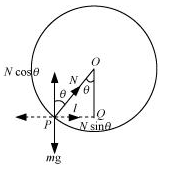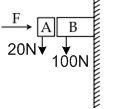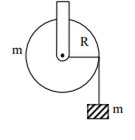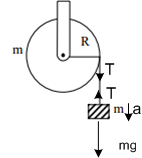A thin circular loop of radius R rotates about its vertical diameter with an angular frequency ω. Show that a small bead on the wire loop remains at its lowermost point for  . What is the angle made by the radius vector joining the centre to the bead with the vertical downward direction for ω =
. What is the angle made by the radius vector joining the centre to the bead with the vertical downward direction for ω =  ? Neglect friction.
? Neglect friction.
Let the radius vector joining the bead with the centre make an angle θ, with the vertical downward direction.

OP = R = Radius of the circle
The respective vertical and horizontal equations of forces can be written as,
mg = N Cosθ ... (i)
mlω2 = N Sinθ … (ii)
In ΔOPQ, we have
Sin θ = l / R
l = R Sinθ … (iii)
Substituting equation (iii) in equation (ii), we get
m(R Sinθ) ω2 = N Sinθ
mR ω2 = N ... (iv)
Substituting equation (iv) in equation (i), we get
mg = mR ω2 Cosθ
Cosθ = g / Rω2 ...(v)
Since cosθ ≤ 1, the bead will remain at its lowermost point for g / Rω2 ≤ 1.
i.e., for ω ≤ (g / R)1/2
For ω = (2g / R)1/2
 ω2 = 2g / R ...(vi)
ω2 = 2g / R ...(vi) On equating equations (v) and (vi), we get
 = g / RCos θ
= g / RCos θ Cos θ = 1 / 2
∴ θ = Cos-1(0.5) = 600 , is the angle made by the radius vector joining the centre to the bead with the vertical downward direction.








